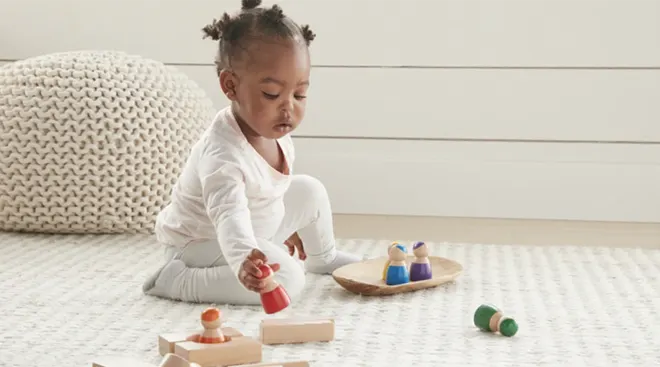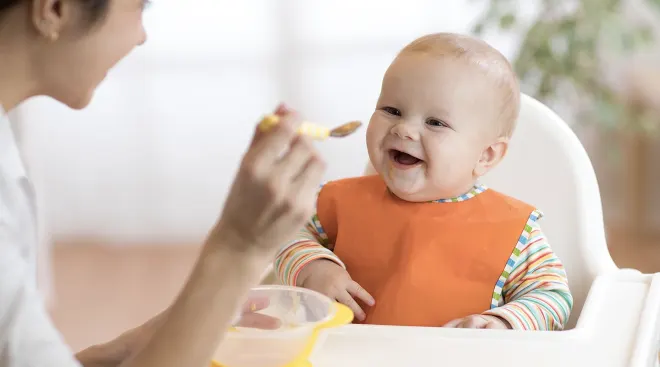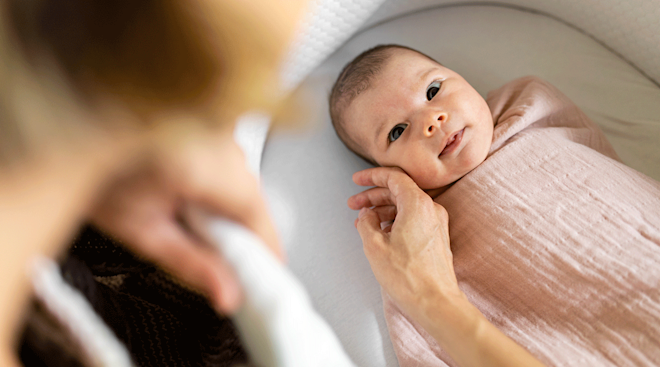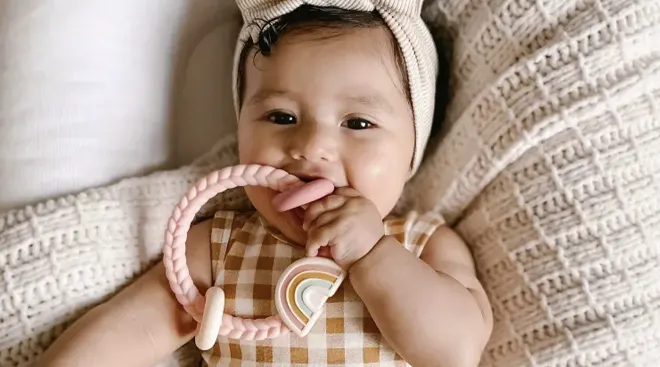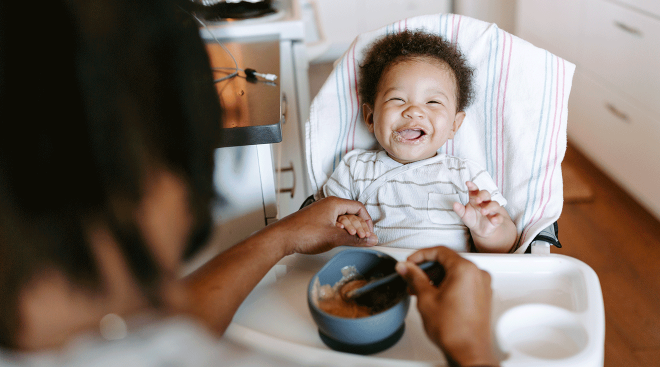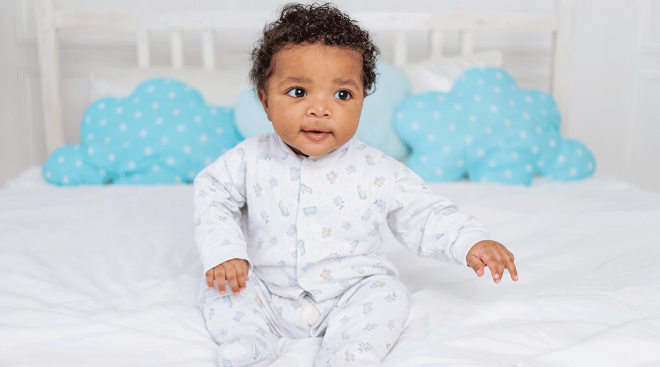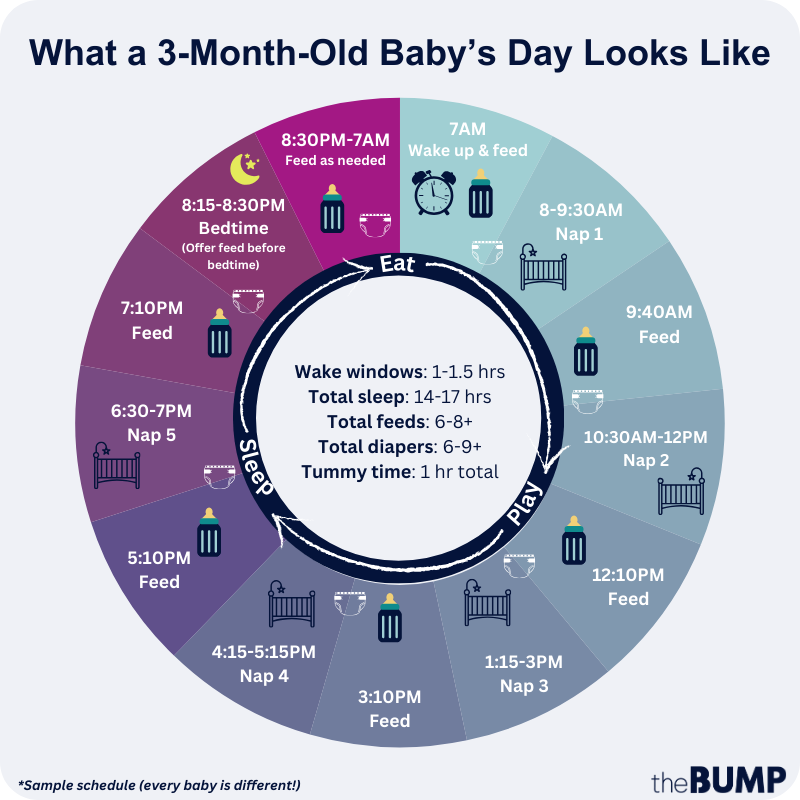3-Month-Old Baby

What a charmer! At 3 months old, baby is probably smiling plenty, and they’ve likely started to imitate what they hear and see. It’s always a good idea to chat with baby throughout the day, describing what you're doing, how you're doing it and where you're going—this is how they’ll eventually learn to talk!
As your 3-month-old baby continues to grow and develop, there are lots of things you’ll want to keep an eye on and a few key 3-month-old baby milestones to watch for. With a whole three months under your parenting belt, you may feel more confident in your child-rearing skills, but you likely have a lot of questions: How often should I feed a 3-month-old? How can you play with a 3-month-old? And let’s not forget: When will my 3-month-old sleep through the night? Ready for the lowdown? Here’s everything you need to know about your budding little person.
- A 3-month-old growth spurt is common, so don’t be surprised if baby’s especially hungry or cranky as a result.
- Baby’s communication skills are rapidly developing: They can now recognize your face, and they may smile when they hear your voice. They may also mimic sounds and start to babble!
- Don't be alarmed if baby loses some hair or has flaky patches on their scalp. This is a peak age for hair loss and cradle cap, which both usually resolve on their own.
It’s common for a 3-month-old baby to go through a growth spurt. Signs of a growth spurt include extra hunger and crankiness. Baby might wake more at night too. Don’t worry—growth spurts are temporary! Let baby eat, sleep or cuddle more if that’s what they seem to want, and try not to get too frustrated by the sudden change. It can be exhausting for you, but growth spurts usually only last one to three days at a time.
You likely want to know: How much should a 3-month-old weigh and measure? The average weight of a 3-month-old baby is between 11.5 and 12.9 pounds for girls and 12.5 and 14.1 pounds for boys; average length is approximately 23.5 inches for girls and 24.2 inches for boys.
Whether baby’s close to the average or not, the important thing is that they’re growing at a healthy rate. They’ve likely gained another 1.5 to 2 pounds and grown 1 to 1.5 inches this month. The size of baby’s head may have gone up by a half inch too.
Baby’s becoming even more active and social at the three-month mark. They’re more in control of their body, more aware of people and more interactive, which makes for lots of fun at playtime. Here are a few big milestones to expect:
- Baby’s mimicking some sounds, movements and expressions and starting to babble.
- A 3-month-old at tummy time probably raises their head and chest, holding up their upper body with their arms.
- Baby opens and closes their hands.
- When you hold baby upright, they’ll push down with their feet onto the floor or your lap.
- They bat at hanging toys above.
- They can grasp and shake a hand toy.
3-month-old sensory development
At 3 months old, baby’s senses have developed rapidly:
- Baby’s working at becoming a great communicator, making eye contact with you, and they can now recognize your face at a distance.
- They follow moving objects with their eyes.
- Baby may smile when they hear your voice.
When to reach out to your pediatrician
You’ll want to look out for these signs of a developmental or medical problem at the three-month stage. It’s worth a call to the doctor if:
- Baby doesn’t respond to loud sounds or smile at the sound of your voice.
- Baby doesn’t follow moving objects with their eyes.
- Baby doesn’t smile socially.
- Baby can’t grasp or hold objects.
- Baby doesn’t bring their hands or objects to their mouth.
- Baby’s eyes still seem crossed most of the time.
- Baby doesn’t coo.
- Baby doesn’t pay attention to new faces.
- Baby doesn’t push down with their feet when they’re held upright and they’re placed on a flat surface.
“Recognize that it’s scary to be in charge of a little one who can’t do anything for themselves, have grace for yourself and reach out to voices of wisdom. Talk to your healthcare provider if you feel like you’re struggling.” — Christine Greves, MD, ob-gyn at the Winnie Palmer Hospital for Women and Babies in Orlando, Florida
As your little one grows, you likely have lots of questions about their health. The next wellness checkup typically takes place at the four-month mark. In the meantime, here are some important things to keep top of mind:
Congestion and coughing
Babies often seem a little stuffy, but if your little one is coughing, has a runny nose, has a fever, is breathing fast or isn’t eating well, check in with your pediatrician. If your 3-month-old is congested, head over here to get more info on how to help them breathe and feel better.
Losing hair
Baby hair loss peaks at around 3 months old. Don’t panic: It’s completely normal for baby hair to fall out, to be replaced by permanent hair. At this age, it’s also not uncommon for their hair to rub off as a result of friction with cribs and infant seats—it’ll grow back once baby starts sitting up.
Ear infections
Ear infections can happen in babies: Telltale clues include if baby’s crying, has a fever, and if they seem irritable and don’t want to eat or sleep. Baby might also have a fever, in which case it’s time to call your pediatrician. If it’s an ear infection, your provider will treat it with antibiotics.
Cradle cap
If baby has scaly patches that flake off, possibly surrounded by a rash, on their head, it’s likely to be cradle cap. This is a common condition that typically resolves in a few weeks or months. In the meantime, you can soothe things by gently massaging baby’s scalp with a fragrance-free shampoo or even rubbing olive oil on it, letting it sit for 30 minutes, combing it out with a cradle cap comb and then washing it out.
Epstein pearls
Epstein pearls are small, white or yellow bumps inside baby’s mouth that look like unerupted baby teeth. Typically caused by keratin buildup, they’re painless and harmless. They typically go away on their own.
Planning your next wellness visit
Don’t forget to schedule baby’s next checkup at 4 months old. At this visit, the doctor will give your little one their second round of vaccines, which include DtaP, Hib, polio, pneumococcal (PCV) and rotavirus.
In the last couple months, baby’s appetite has certainly increased! And they know how to tell you when they’re hungry. Of course, you’ve probably gotten into such a routine with feeding that you know when they’re about to do that hungry cry. When in doubt, look for hunger cues. Before crying for their food, baby may lick their lips, stick out their tongue, repeatedly open their mouth, suck on things or touch their hands to their mouths. These can all be signals that it’s feeding time.
At this stage, baby is still only able to eat breast milk and/or formula. Many parents ask: “Can I give my 3-month-old water?” Nope! Most doctors recommend parents wait until baby’s ready for solid foods before they get water. Don’t worry, baby’s getting plenty of hydration from breast milk or formula and needs the nourishment it provides.
How much should a 3-month-old eat?
- Breastfeeding: How often should a 3-month-old nurse? Feedings are typically about every three or four hours at this age, but each breastfed baby may be slightly different. What’s important is that baby seems content, your breasts seem to have been emptied (they’re soft) and baby’s gaining weight healthily.
- Bottle feeding: How much formula for a 3-month-old baby? Typically 5 ounces about six to eight times a day will suffice.
To double-check that baby’s getting enough breast milk, you can also track their diapers. How many wet diapers for a 3-month-old baby? At least four or five very wet ones per day indicate that your little one is getting ample milk.
Around 3 months old, you might notice baby waking up more often at night. At this age, babies’ brains are becoming more alert and because of that, they want to be using that brainpower more often. Growth spurts can last a few days but true sleep regression (which typically happens closer to 4 months) can last two to six weeks.
Here’s what else you need to know about baby’s sleep at this stage—so you can be prepared for any curveballs down the road.
3-month-old sleep schedule
Three-month-olds typically sleep about 15 hours a day, and more of those hours are falling at night. In fact, it’s common for 3-month-olds to sleep about 10 hours at night, with at least one five- or six-hour stretch (woohoo!). Baby is probably taking three naps totaling five hours of daytime sleep.
The ideal bedtime for a 3-month-old baby depends on your family’s schedule, but many experts believe 7:30 p.m.—give or take—is ideal at this age. As baby begins to sleep for longer stretches at night, you’ll want to gradually make bedtime earlier, which (surprisingly!) encourages baby to sleep even longer. Of course, ultimately baby’s bedtime will vary—and change!—based on what works best for you.
How can I get my 3-month-old to sleep?
It’s harder than you might think to get a tired baby to actually go to sleep! You’ve probably heard the usual advice: Keep the room dark and cool, rock and sing to baby, and put baby to sleep while they’re sleepy but not yet asleep. Still, there are some nights when none of that seems to work. Try some other parents’ tried-and-true tricks for calming a fussy baby; they just might help you get your little one to snooze—finally.
At 3 months old, baby’s wake windows are about 60 to 90 minutes long and they’re still taking quite a few naps during the day. While every baby’s different, a 3-month-old’s daily schedule might look something like this:
Be sure to squeeze in some playtime with your 3-month-old baby each day. How can you engage and play with a 3-month old? There are tons of ways to entertain your cutie pie at this stage.
- Give baby a mirror and let them admire their reflection.
- Sing, read and talk to your 3-month-old baby; encourage them to make sounds of their own. This sweet back-and-forth is the basis of an early conversation!
- Place a soft and colorful toy on baby’s chest and let them look, touch and play with it. A play gym or mobile can also provide plenty of amusement.
- Let baby play under a baby gym, since they love to kick up a storm, swing at things and bat at any dangling toys they see.
- Continue to put baby on a mat for tummy time. The more baby gets used to being on their tummy, the more they’ll be inclined to start working toward rolling or even crawling.
Time is moving fast! Here are some tips you might want to keep in mind this month.
Postpartum recovery tips
- Postpartum hair loss may be happening. Don’t worry if you see some hair falling out: It’s common to notice postpartum hair loss around this time. Your hormones are returning to normal levels, which allows your hair to go back to its normal cycle of growing and falling out. While your hair may seem thinner than normal, it should grow back within a few months.
- Dealing with clogged ducts and mastitis. Mastitis is one of the most common challenges for breastfeeding moms. If you suspect that you have a clogged duct or mastitis, make sure to contact your doctor about next steps. Mastitis is usually treated with antibiotics. Frequently feeding or pumping may help, along with anti-inflammatory medications. Your milk supply may slow down at this time, but it should improve as you recover as long as you keep breastfeeding or pumping.
- Emotionally preparing to return to work. If you’re going back to work, it’s important to recognize that this will be a transition for you and baby: Give yourself grace during this transition. Talk to your child’s pediatrician and your future childcare to find out what you need to do in advance to prepare baby for time without you.
3-month-old baby care tips
Here are a few tips to keep in mind at the three-mark mark:
- Choosing cloth vs. disposable diapers. There are pros and cons to each of these choices: Cloth diapers are certainly more sustainable, but disposable diapers have an undeniable convenience factor. Also, keep in mind that some daycares may not allow cloth diapers.
- Introducing formula. If you’re planning to give baby formula, try introducing a bottle at the end of a breastfeeding session to see if baby likes it. You may also choose to combination feed for various reasons.
- Avoiding baby powder. Baby powder is not recommended. Talc-based baby powder can contain asbestos fibers, which baby could accidentally breathe in and become sick. If you’re concerned about diaper rash, talk to baby’s pediatrician at your next well child visit.
- Using baby sunscreen. Babies younger than 6 months should be kept out of direct sunlight. For babies younger than 6 months, the American Academy of Pediatrics (AAP) recommends using sunscreen on small areas of the body, like the face, if there is no protective clothing or shade available.
- Wiping skin folds. Baby’s skin folds can end up harboring gunk and dirt. Clean baby’s skin folds regularly with a damp washcloth, and dry them completely with a towel. Damp areas like skin folds can be breeding grounds for fungus and skin infections, so it’s important to keep them clean and dry.
- Following car seat safety. First, make sure you’ve installed your baby’s car seat correctly by checking the manuals for both your car and the car seat. The seat should be installed securely in the back seat, ideally in the center seat. Since baby is safest riding rear-facing, the seat should face backwards. Recline it a bit, to help prevent baby’s head from flopping forward. Then, before you place baby in the seat, take off any bulky clothing they’re wearing. That way, you’ll be able to fit the harness straps snugly over their body to keep them secure.
Looking for parenting inspiration? Let these stories from real parents inspire you on your own 3-month-old journey.
- Win: “Swaddling helps a lot. Our son sleeps through the night (eight to 10 hours at a time), and one thing that I think helped us get there was making sure he sleeps plenty during the day. I nap him every two hours at the most. Before 2 months, he slept horribly at night—up every two to four hours!—but then I started making sure he slept well during the day and it really made a difference. Try it if you're not already!” — lauraandjim
- Challenge: “I’m trying to get my 3-month old used to being out and around loud noises. We haven’t had too many outings the first two months, but started mommy-and-me classes a few weeks ago. Whenever we go out to a restaurant, she’ll scream and cry and is hard to calm down (she’ll fuss to the point she exhausts herself and falls asleep). I make sure she’s fed, changed and had a good nap before going out.” — ahrob135
- Wisdom: “Your babies are only small once. You’re going to wake up one day and your LO will be on the go and will have no interest in being snuggled and rocked to sleep, and you’ll miss those early days when they wanted you all the time (even if you didn't get a ton of sleep). Don't worry about sleep training in the early months. You can do that down the road when it's more developmentally appropriate.” — kcisthebombdotcom
“My second baby had very bad colic. He would scream and cry like clockwork from 1 to 5 a.m. every night for no reason. This lasted for six months. Nothing we did made it any better. We tried meds for reflux, tummy exercises and so forth with no success. … The pediatrician kept telling us that colic didn’t last forever and it would pass eventually, and it did. After six long months.” — Aghogho Oluese, mom of two in Queens, New York
Frequently Asked Questions
Is there a safe way to co-sleep with a 3-month-old baby?
The AAP strongly advises against sharing a bed with infants under the age of one to lower the risk of Sudden Infant Death Syndrome (SIDS). However, the AAP recommends sharing a room with baby—with your child in their own crib or bassinet—for at least the first 6 months.
How can I tell if baby is overstimulated?
There are a few signs. More subtle cues include turning away from touch, noise or action in the room, thrashing arms and legs and clenching fists. Rubbing their eyes, covering their face, and yawning may also be signs. Crying is the most common sign baby is overstimulated, but that usually comes later. Hot tip: Noticing signs of overstimulation early and taking baby to a calm, quiet, dark place can help to prevent a meltdown.
How far can a 3-month-old see?
By 3 months, baby should be able to spot people at a distance. Your child also should be able to focus on faces and close objects. Baby will also likely be able to follow moving objects with their eyes.
When will baby stop crying so much?
If baby’s crying a lot, it might be time to play detective. The AAP suggests keeping a diary to see if there are patterns to the crying, for example if it’s a reaction to something baby’s eating. A food sensitivity could be the culprit, in which case (if breastfeeding) you could try to change up your diet, or (if formula-feeding) you could talk to your pediatrician about trying a different formula. Baby could also be hungry, cold or hot, have acid reflux, be overstimulated or simply bored. To calm baby, the AAP suggests playing a calming sound like white noise, walking baby in a carrier, or holding baby in your arms and placing them on their left side, which can help with digestion.
If baby’s crying for three or more hours a day on three or more days a week, it could be colic—in which case it’s a good idea to check in with your pediatrician. Thankfully, colic typically resolves by the time baby is 3 to 4 months old.
What if my 3-month-old hates tummy time?
We’ve been there! Your baby is not alone if they hate tummy time. This is hard work for babies, who are developing the muscles in their neck, which can be uncomfortable and frustrating. To help baby with tummy time, set them on your chest and interact with them. During traditional tummy time, try setting toys or a mirror nearby, or reading a colorful picture book to distract baby.
A heads up that in the coming weeks, you’ll be entering new and exciting territory: a more mobile baby! Baby will work on those important 3-month-old baby milestones, and you’ll have even more to look forward to as they approach month four—like better head control and maybe even rolling from tummy to back. Get your camera ready!
Please note: The Bump and the materials and information it contains are not intended to, and do not constitute, medical or other health advice or diagnosis and should not be used as such. You should always consult with a qualified physician or health professional about your specific circumstances.
Navigate forward to interact with the calendar and select a date. Press the question mark key to get the keyboard shortcuts for changing dates.

































